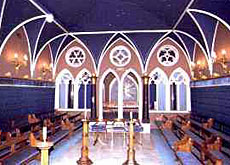
Zurich’s freemasons go public

Switzerland’s freemasons are hoping to improve their public image with a new display of openness.
Efforts to lift the veil of secrecy coincide with the 150th anniversary of the Zurich Modestia cum Libertate lodge.
With their members-only rule, the freemasons have always been considered a secret society. And the secrecy surrounding the lodges, the archaic rituals and symbols have given rise to suspicion and prejudice.
Alfred Messerli, who organised a recent exhibition on freemasonry, said the Zurich lodge was trying to dispel prejudice and to present itself to the public in a different light.
“The public still wrongly perceives us as a secret society,” Messerli told swissinfo.
“By addressing the public directly, we wish to convince them that this image is wrong, that we have no secrets and nothing to hide.”
Historical development
The history of freemasonry is believed to go back to the medieval church masons’ guild in England.
The terms “lodge” and “freemason” were first used in the 13th and 14th centuries. The lodge was the workplace of stonemasons, bricklayers and architects who were involved in constructing churches and large buildings.
According to Messerli, the modern movement started in 1717 when four lodges joined forces to found the first Grand Lodge in London.
In 1723 the “Constitution of Freemasonry” was published.
“[The constitution] is a rulebook that is still in force today and has not changed,” Messerli explained.
From 1717, freemasonry started spreading across Europe and lodges gradually opened up to accept people other than stonemasons, bricklayers and architects.
Messerli said from then on members were no longer involved in actually building a cathedral or a church but engaged in symbolically constructing an ethical structure for a more humane society.
The exhibition revealed that personalities from politics, business and the world of literature and music – Churchill, Mozart and Goethe to name but a few – were freemasons.
Freemasonry in Switzerland
As the movement spread throughout 18th-century Europe, freemasons started founding lodges in Switzerland.
By 1844 – the year when the Swiss Grand Lodge Alpina was founded – there were more than 30 lodges all over Switzerland.
Master mason Jacques Laager explained that the ideals of freemasonry, which went back to the philosophy of the stoics and the Enlightenment, were based on the principles of humanity, brotherly love, tolerance and cosmopolitanism.
“The ideas of humanity can only thrive in a democratic and open society,” he said.
According to the freemasons, the Swiss Federal Constitution of 1848 is based on these same principles.
Opposition
Switzerland is the only country worldwide which has tried to ban freemasonry.
After Hitler rose to power in Germany, right-wing Swiss colonel Arthur Fonjallaz launched an initiative to ban freemasonry and secret societies. His initiative was rejected by the Swiss people in 1937.
In the past freemasonry has often met with fierce opposition from totalitarian regimes, leading to oppression and persecution of its members worldwide.
According to Messerli, this hostility explains why Masonic brotherhoods have always kept to themselves.
“The thoughts of a small community become more powerful when its members keep them to themselves rather than shout from the hilltops,” he said.
Ideas and goal
Based on the Charges of A Freemason, which allow “only a free man of good repute to become a freemason”, the society has traditionally been exclusively male.
Any man irrespective of social background can become a member if he adheres to the moral and spiritual ideals of freemasonry.
“The main objective of freemasonry is to work towards one’s own perfection in order to become a better human being,” Messerli explained.
To be able to help build the symbolic temple of humanity, freemasons need to pass through the three stages of apprentice, fellow and master.
These are rituals that take place in the centre of a lodge, the temple. It represents the cosmos and is full of symbols that play an important part in freemasonry.
Ranging from an unpolished stone and a hammer to the sun and the moon, these symbols are meant to help the individual understand his personality and achieve the goal of perfection.
swissinfo, Katalin Fekete
The number of freemasons worldwide is estimated at 5 million.
The Swiss Grand Lodge Alpina – the umbrella organisation of the Swiss lodges – includes 80 lodges and 3,800 members.
There are 11 women’s lodges, eight in French-speaking Switzerland and three in the German-speaking part – Zurich, Bern and Basel.
The Zurich Modestia cum Libertate lodge staged a recent exhibition as well as a series of lectures on freemasonry to mark its 150th anniversary.
The events were aimed at restoring the image of the movement and arousing public interest.

In compliance with the JTI standards
More: SWI swissinfo.ch certified by the Journalism Trust Initiative





























You can find an overview of ongoing debates with our journalists here . Please join us!
If you want to start a conversation about a topic raised in this article or want to report factual errors, email us at english@swissinfo.ch.